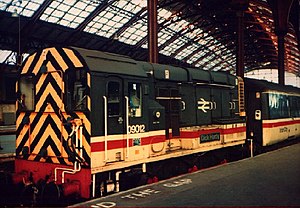British Rail Class 09
| British Rail Class 09 | |||||||||||||||||||||||||||||||||||||||
|---|---|---|---|---|---|---|---|---|---|---|---|---|---|---|---|---|---|---|---|---|---|---|---|---|---|---|---|---|---|---|---|---|---|---|---|---|---|---|---|
 09012 at Brighton station | |||||||||||||||||||||||||||||||||||||||
| |||||||||||||||||||||||||||||||||||||||
| |||||||||||||||||||||||||||||||||||||||
| |||||||||||||||||||||||||||||||||||||||
| |||||||||||||||||||||||||||||||||||||||
The British Rail Class 09 is a class of 0-6-0 diesel locomotive designed primarily for shunting and also short distance freight trips along branch lines.[1]
The 26 locos are similar to the Class 08 shunting locomotives but have different gearing, giving a top speed of 27.5 mph (44 km/h) at the expense of a lower tractive effort. They were introduced from 1959 to 1962 and latterly operated in the Southern Region of British Railways, although some of the class were originally allocated to depots in the Midlands and North before transferring south. [2] Further locomotives were converted from Class 08 in 1992 and, following this and privatisation in 1997, the class has been distributed much further afield.
Sub-classes
Class 09/0
The original 26 locomotives (built 1959-62) became sub-class 09/0 when further locomotives were modified from Class 08 in 1992 which became subclasses Classes 09/1 and 09/2. There were variations, which were given the following TOPS design codes:
- 09-0AX Original design; weight 50.4 te[clarification needed] (502 kN); dual brakes
- 09-0BA 51 te (510 kN), air brakes; RA6, knuckle couplings fitted [09003/11]
Classes 09/1 & 09/2
These locomotives were modified from Class 08 in 1992. TOPS numbers were 09 101 – 09 107 and 09 201 – 09 205. The design codes were as follows:
- 09-1AX 110 V electrical system; 50.4 te (502 kN); dual brakes; formerly 20 mph (32 km/h) locomotive
- 09-1BX 110 V electrical system; 50.4 te (502 kN); dual brakes; formerly 15 mph (24 km/h) locomotive
- 09-1CX 110 V electrical system; 49 te (488 kN); dual brakes; fitted with knuckle couplings
- 09-1EA 110 V electrical system; 51 te (508 kN); air brakes; RA6; fitted with knuckle couplings
- 09-2AA 90 V electrical system; 49.6 te (494 kN); air brakes
- 09-2BX 90 V electrical system; 50.5 te (503 kN); dual brakes
- 09-2DA 90 V electrical system; 51 te (508 kN); air brakes; RA6; fitted with knuckle couplings
Passenger operations
Although not normally considered for passenger work, Class 09s were recorded working passenger trains between Clapham Junction and Kensington Olympia due to unavailability of the booked Class 33 diesel.[3]
They were also used on Railtours which needed to depart Brighton heading along the West Coastway Line or vice versa. To achieve this the 09 worked between Brighton and Preston Park, allowing main tour locomotive to work the train forward via the Cliftonville tunnel and Hove.[4] The connection to the West Coastway Line at Brighton can only be used by four car trains due to the arrangement of the points and track.
Liveries
Post-Privatisation
The following liveries have been carried since the privatisation of British Rail:
- 09006/007/019/024 carried Mainline Freight livery[5]
- 09025 in Connex Livery[1]
- 09201 in Railfreight grey and is currently in the Knottingley area working at EWS Depot
Preservation
10 of the 26 "class 09" diesel shunter locomotives have been preserved[6]
- 09001 Ex DB Schenker at Peak Rail (Heritage Shunters Trust)
- D3668 (09004) at Swindon & Cricklade Railway
- D3721 (09010) at South Devon Railway
- D4100 (09012) 'Dick Hardy' at Severn Valley Railway (following sale to the railway Feb 2013)
- 09017 at National Railway Museum
- 09018 at Bluebell Railway
- 09019 at West Somerset Railway
- 09024 at East Lancashire Railway
- D4113 (09025) at Lavender Line[7]
- 09026 'Cedric Wares' at Spa Valley Railway
References and sources
References
- ^ a b Class 09 semgonline.com
- ^ http://www.brdatabase.info/locoqry.php?action=class&id=9&type=D&page=alloc
- ^ Lund, E (1980). To the last drop. Chesterfield: Longden technical Publications. ISBN 0-9507063-0-2.
- ^ "20th April 1996 Pathfinder Tours The Southern Coasterman". Six Bells Junction. Retrieved 14 January 2009.
- ^ "Mainline Freight". Class 58 Locomotive Group. Retrieved 8 December 2009.
- ^ Marshall, A. (2007) Preserved Heritage Traction, GM Publications, Leeds, UK, ISBN 978-0-9555581-0-8
- ^ "New Diesel Arrival Class 09 09025". The Lavender Line. Isfield Station, East Sussex. 16 October 2014. Retrieved 18 January 2015.
Sources
- Marsden, Colin J. (1981). Motive power recognition:1 Locomotives. Shepperton: Ian Allan Ltd. ISBN 0-7110-1109-5.
- Strickland, David C. (September 1983). Locomotive Directory: Every Single One There Has Ever Been. Camberley: Diesel and Electric Group. pp. 53–61. ISBN 978-0-906375-10-5. OCLC 16601890. OL 27959920M. Wikidata Q105978499.
- [1]
